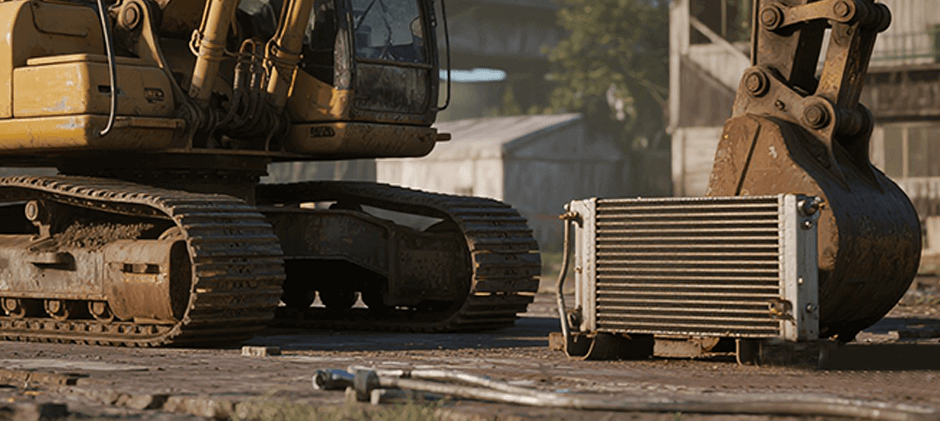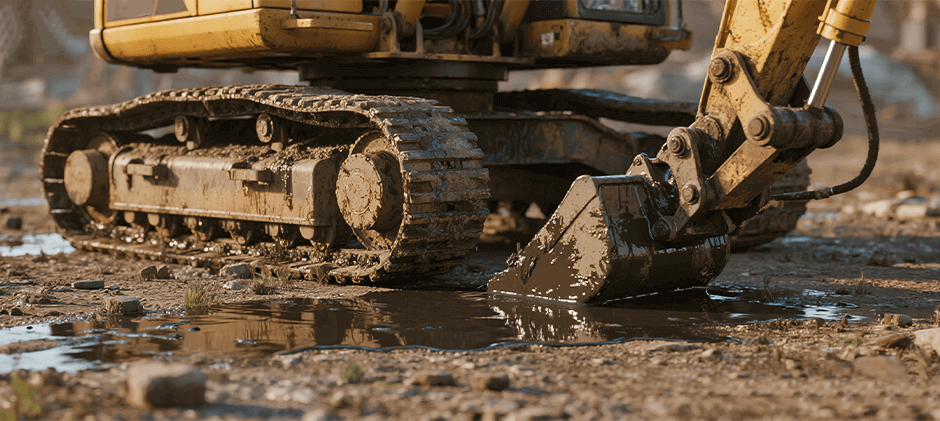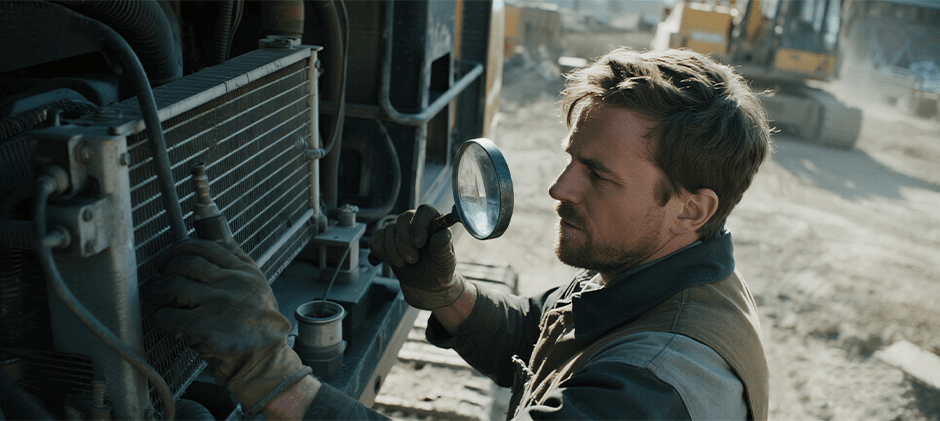The oil cooler may not look like much, but it plays a big role in keeping your heavy equipment running smoothly. Keeping engine oil cool and flowing helps prevent overheating, reduces wear on engine parts, and even improves fuel efficiency. But when an oil cooler starts to fail—due to cracks, clogs, or age—you’ll start noticing real trouble: rising oil temps, overheating, strange smells, and even unexpected breakdowns.
In this article, we’ll walk you through what an oil cooler does, how to spot early warning signs of failure, and when to replace or upgrade it. A few minutes of reading now could save you hours of repair time later.

What Is an Oil Cooler and What Does It Do?
An engine oil cooler is a type of heat exchanger. Its sole purpose is to remove excess heat from the engine oil. As oil circulates through a hard-working engine, it lubricates moving parts and absorbs a massive amount of heat from components like the pistons, crankshaft, and turbocharger. Without a way to shed this heat, the oil would quickly overheat.
The oil cooler accomplishes this in one of two ways:
- Oil-to-Air Cooler: This type works like a small radiator. Hot oil flows through a series of tubes and fins, and ambient air (often forced by a fan) passes over them, carrying the heat away.
- Oil-to-Coolant Cooler: This is a ubiquitous design in heavy-duty diesel engines. The oil cooler is a sealed unit where oil flows through one set of internal passages while engine coolant flows through another. The heat transfers from the hot oil to the cooler coolant, which then carries the heat to the main radiator to be dissipated.
In either case, the goal is the same: to keep the engine oil within its ideal operating temperature range, ensuring it can lubricate effectively.
Why Are Oil Coolers Important?
On heavy machinery, an oil cooler is not optional. The sustained high loads and RPMs generate far more heat than in a typical passenger vehicle. If the oil is not properly cooled, two very bad things happen:
- Viscosity Breakdown: The oil becomes too thin. Proper oil viscosity (its thickness) is essential for creating a strong, protective film between moving metal parts. When the oil thins out from excessive heat, this film can break down, leading to direct metal-on-metal contact, increased friction, and rapid wear.
- Chemical Degradation: Extreme heat accelerates the breakdown of the oil itself, causing it to oxidize and form sludge and carbon deposits. This sludge can clog narrow oil passages within the engine, starving critical components like bearings and valve trains of lubrication.
An oil cooler is the difference between an engine that lasts 15,000 hours and one that fails at 5,000. It’s the unsung hero of engine longevity in high-stress applications.

5 Signs of a Bad Oil Cooler: Quickly Check
When your oil cooler starts to fail, your engine doesn’t stay quiet about it—it screams for help. Below are some of the most telling symptoms that your oil cooler might be in trouble. Miss them, and you could be looking at a costly repair bill.
- Oil in the Coolant: This is the number one, undeniable sign of an internal oil cooler failure. When you check your coolant reservoir or radiator (only when the engine is cool), you will find a thick, milky, or sludgy substance that looks like chocolate milk or mayonnaise. This is a classic symptom of an oil cooler leaking oil into the coolant.
- Coolant in the Oil: This is the other side of an internal breach and is even more dangerous. When you check the engine’s dipstick, the oil will have a milky or frothy appearance. This means the coolant has contaminated your engine’s lubrication system.
- External Oil Leak: You may notice oil drips on the ground beneath the engine or see a wet, grimy film of oil on the side of the engine block, typically around the oil filter and cooler assembly.
- Engine Overheating: If your temperature gauge is consistently running hotter than normal or creeping into the red zone, especially when the machine is under load, a faulty oil cooler is a prime suspect.
- Loss of Engine Performance: The engine may feel sluggish, lack power, or you might hear new noises like a faint knock or tick. This is often a secondary symptom caused by poor lubrication from oil that is too hot or contaminated.
What Causes Oil Cooler Failure?
So, you’ve seen the symptoms, but what’s actually happening inside the engine to cause them? An oil cooler failure isn’t a single event; it’s the result of a tough life in a demanding environment. Understanding what causes oil cooler failure involves looking at both the external forces acting on the part and the specific physical damage they create. Let’s break down this cause-and-effect relationship.
Cause 1: Extreme Heat Cycles and Fluid Contamination
The constant cycle of heating up to operating temperature and cooling down puts immense thermal stress on the oil cooler’s metal, welds, and especially its seals. At the same time, the quality of the fluids passing through it is critical.
The Resulting Problems:
- Gasket and Seal Failure: This is one of the most frequent failure points. Over thousands of hours, the heat makes rubber gaskets and O-rings hard and brittle. They lose their flexibility, shrink, and can no longer maintain a proper seal, leading to external oil leaks.
- Internal Clogging and Corrosion: If engine oil isn’t changed on schedule, it breaks down and forms sludge. Similarly, old or low-quality coolant can become corrosive. This debris and corrosion build up inside the tiny passages of the cooler, creating blockages. A clogged cooler restricts oil flow, leading directly to overheating.
Cause 2: Constant Vibration and Physical Stress
Heavy machinery is a world of constant, powerful vibrations. Every jolt, every bump, and the hum of the high-horsepower engine sends vibrations through every component, including the oil cooler.
The Resulting Problems:
- Cracks and Leaks: Over time, these vibrations can fatigue the metal, causing microscopic cracks to form in the cooler’s housing, at its mounting points, or along its welded seams. These cracks inevitably grow and become a source of external oil leaks.
- External Physical Damage: For air-cooled units, which are often mounted near the radiator, there’s a constant risk of impact from rocks, branches, and other job site debris. A direct hit can easily puncture the cooler or damage its delicate cooling fins, compromising its function.
Cause 3: Internal System Pressure
The oil system operates at a much higher pressure than the cooling system. While this is normal, certain issues can turn this pressure into a destructive force.
The Resulting Problems:
- Internal Ruptures: If the cooler has been weakened by corrosion or if the engine experiences a pressure spike (e.g., from a stuck oil pressure relief valve), the high-pressure oil can rupture the thin internal walls separating it from the coolant passages. This is the direct cause of the most severe bad oil cooler symptoms, creating the internal breach that allows for oil cooler leaking oil into coolant and vice versa.

Why Are Oil Coolers Important?
On heavy machinery, an oil cooler is not optional. The sustained high loads and RPMs generate far more heat than in a typical passenger vehicle. If the oil is not properly cooled, two very bad things happen:
- Viscosity Breakdown: The oil becomes too thin. Proper oil viscosity (its thickness) is essential for creating a strong, protective film between moving metal parts. When the oil thins out from excessive heat, this film can break down, leading to direct metal-on-metal contact, increased friction, and rapid wear.
- Chemical Degradation: Extreme heat accelerates the breakdown of the oil itself, causing it to oxidize and form sludge and carbon deposits. This sludge can clog narrow oil passages within the engine, starving critical components like bearings and valve trains of lubrication.
An oil cooler is the difference between an engine that lasts 15,000 hours and one that fails at 5,000. It’s the unsung hero of engine longevity in high-stress applications.
How to Know if My Oil Cooler Is Damaged?
If you suspect a problem, follow these diagnostic steps:
- Start with a Visual Inspection: With the engine off and cool, carefully inspect the oil cooler, its lines, and the area around it. Look for any signs of wetness, fresh oil, or grime buildup that indicates a leak.
- Check the Fluids: This is your most important diagnostic tool.
- Pull the engine oil dipstick. Look for a milky color or water droplets.
- Open the coolant reservoir. Look for a dark, oily sheen or thick sludge.
- Monitor the Gauges: Pay close attention to your oil pressure and coolant temperature gauges during operation. Any abnormal readings are a red flag.
Seek Professional Diagnosis: If you see signs of internal mixing, the best course of action is to have a mechanic perform a pressure test on the cooling system and the oil cooler itself. This can confirm definitively where the breach is located.
How Long Does an Oil Cooler Last?
In the world of heavy machinery, an oil cooler is a wear item. Its life depends entirely on the intensity of the work, the quality of maintenance, and the operating environment. While some oil coolers can be expected to last 100,000 to 150,000 miles under normal conditions, equipment that is put through heavy loads every day, especially off-highway equipment, may need to be replaced sooner. It’s best to consider it a component that requires regular inspection and will likely need replacement at some point during the engine’s life.
Conclusion
The engine oil cooler is a small but essential guardian of your heavy equipment’s engine. Being able to recognize the bad oil cooler symptoms—especially the mixing of oil and coolant—is a non-negotiable skill for any owner or operator. Acting quickly on these signs is the key to preventing minor issues from turning into budget-breaking engine failures. Proactive inspection and timely replacement will save you money, eliminate downtime, and ensure your machinery remains reliable and productive for years to come.
If your inspections have revealed a faulty oil cooler, FridayParts has the solution. As a premier supplier of high-quality aftermarket parts, we offer a vast inventory of oil coolers for top heavy equipment brands like Caterpillar, Komatsu, John Deere, and many more, all at affordable prices. Don’t wait for a small leak to become a big problem.
